RNA Exosomopathies:

Researchers at Emory University and the University of Texas Health Science Centre have shown that mutations causing brain defects in humans also produce similar effects in budding yeast (Saccharomyces cerevisiae), a simpler eukaryotic organism.
- These mutations affect a cellular complex called the RNA exosome, which plays a critical role in RNA processing, surveillance, and degradation.
- This reveals the potential to use yeast as a model organism for studying human neurological disorders, particularly those related to RNA exosome dysfunction.
- RNA exosomopathies are disorders caused by mutations in genes coding for RNA exosome components.
- These disorders primarily lead to brain maldevelopment, affecting structures like the pons and cerebellum.
- A key example is Pontocerebellar Hypoplasia Type 1 (PCH1), which results in severe motor, cognitive, and developmental impairments in infants.
- The RNA exosome is a multi-protein complex discovered in yeast in 1997.
- It is responsible for: Processing, surveillance, and degradation of different types of RNA molecules, Maturation of ribosomal RNA (rRNA) – essential for building ribosomes, Elimination of faulty messenger RNA (mRNA) and regulation of non-coding RNAs (ncRNA).




